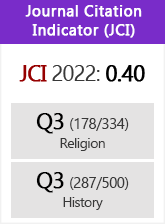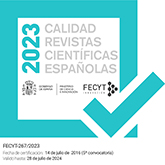De Statuis: christian sources on the “Riot of statues”
DOI:
https://doi.org/10.3989/hs.2016.029Keywords:
Antioch, Christian Literature, Meletian Schism, emperor TheodosiusAbstract
The historical account of the “Riot of the Statues” of A.D. 387 Antioch found in Christian authors coetaneous to the event and from the Vth century A.D. is provided from different literary genres but approached with common narrative lines. The decisive intervention of the Meletian group of the Antiochene Church in order to obtain the emperor Theodosius’ forgiveness and his portrait as a submissive ruler to Christian figures are the main leitmotifs in the accounts of John Chrysostom, Ambrose of Milan, Sozomenus and Theodoretus of Cyr.
Downloads
References
Ashbrook-Harvey, S. 2000. "Antioch and Christianity", en C. Kondoleon (ed.), Antioch, The Lost Ancient City: 38-49. Princeton: Princeton University Press.
Auski, P. 1995. Christian Plain Style: The Evolution of an Spiritual Ideal. Montreal: McGill-Queen’s University Press.
Barterlink, G.J.M. 1970. "Quelques observations sur parrhésia dans la littérature paleochrétienne", en Mohrmann, C. et al. (eds.), Gracietas et Latinitas. Christianorum Primaeva. Studia ad sermonem christianum primaevum pertinentia: 7-57. Nimega: Dekker & van de Vegt.
Brottier, L. 2004. "Jean Chrysostome. Un pasteur face à des demi-chrétiens". Topoi 5: 439-457.
Brown, P. 1972. Religion and Society in the Age of Saint Augustine. Londres: Faber and Faber.
Brown, P. 1992. Power and Persuasion in Late Antiquity. Towards a Christian Empire. Madison: University of Wisconsin Press.
Browning, R. 1952. "The riot of A.D. 387 in Antioch. The role of the theatrical Claques in the Late Empire". Journal of Roman Studies 42: 13-20. https://doi.org/10.2307/297505
Bruun, P. 1976. "Notes in the transmission of Imperial Images in Late Antiquity", en Ascani, K. et al. (eds.), Studia Romana in Honorem Petri Krarup septuagenarii: 122-131. Odense: Odense University Press. PMCid:PMC274281
Buenacasa, C. 1997. "La figura del obispo y la formación del patrimonio de las comunidades cristianas según la legislación imperial del reinado de Teodosio I". Studia Ephemeridis Augustinianum 58.1: 121-139.
Calvo Martínez, J.L. 1992. "La Diosa Hécate: un paradigma de sincretismo religioso del helenismo tardío". Florentia Iliberritana 3: 71-82.
Canivet, P. 1977. Le monachisme syrien selon Theodoret de Cyr. París: Beauchesne.
Canivet, P. y Leroy-Molinghen, A. 1997. Théodoret de Cyr. Histoire des Moines de Syrie. París: Editions du Cerf.
Cavallera, F. 1905. Le schisme d'Antioche. París: A. Picard.
Chadwick, H. 1984. "Oracles of the End in the Conflict of Paganism and Christianity in the Fourth Century", en Luchhesi, E. y Saffrey, H.D. (eds.), Mémorial A-J. FESTUGIERE. Antiquité païenne et chrétienne: 125-129. Ginebra: P. Cramer.
Chadwick, H. 2001. The Church in Ancient Society. From Galilee to Gregory the Great. Oxford: Oxford University Press. https://doi.org/10.1093/0199246955.001.0001
Chesnut, G. 1977. The first Christian Histories. Eusebius, Socrates, Sozomen, Theodoret, and Evagrius. París: Beauchesne.
Cracco Ruggini, L. 1977. "The Ecclesiastical Histories and the Pagan Historiography: providence and miracles". Athenaeum 55: 107-126.
Depeyrot, G. 1996. Crisis e inflación entre la Antigüedad y la Edad Media. Barcelona (trad.): Crítica.
De Sainte Croix, G.E.M. 1988. La lucha de clases en el mundo griego antiguo. Barcelona (trad.): Crítica.
Downey, G. 1961. A History of Antioch in Syria: from Seleucus to the Arab Conquest. Princeton: Princeton University Press. https://doi.org/10.1515/9781400877737
Downey, G. 1962. Antioch in the age of the Theodosius the Great. Oklahoma: University of Oklahoma Press.
Faraone, C. 1997. "Hymn to Selene-Hecate-Artemis from a Greek Magical Handbook (PGM 2714-83)", en Kiley, M. (ed.), Prayer from Alexander to Constantine: 195-199. Londres: Routledge.
Farnell, L.R. 1896. "Hecate in Art", en Farnell, L.R. (ed.), The Cults of the Greek States: 36-54. Oxford: Clarendon Press.
Festugière, A.-J. 1961. Les moines d'Orient, vol. I. París: Edition du Cerf.
García Fernández, J.M. 1995. "La autocefalia de la Iglesia chipriota, una consecuencia del cisma del siglo IV en la cristiandad de Antioquía". Espacio, Tiempo y Forma Serie II, Hª. Antigua 8: 501-505.
García Teijeiro, M. 2005. "De maga a bruja. Evolución de la hechicera en la Antigüedad clásica", en Pedregal Rodríguez, M.A. y González, M. (eds.), Venus sin espejo: imágenes de mujeres en la Antigüedad clásica y el cristianismo primitivo: 33-53. Oviedo: KRK Ediciones. PMid:15984680
Guidorizzi, G. 1995. "La letteratura dell'irrazionale", en Cambiano, G.; Canfora, L. y Lanza, D. (eds.), Lo Spazio Letterario della Grecia Antica, vol. II: 591-627. Roma: Salerno.
Guinot, J.N., 2001. "L'Histoire du siège d'Antioche relue par Jean Chrysostome. Idéalisation ou déformation intentionelle?", en Cabouret, B.; Gatier, P.L. y Saliou, C. (eds.), Antioche de Syrie. Histoire, images et traces de la ville Antique: 459-479. Lyon: De Boccard.
Harden, D.B. 1927. "A Series of Terracottas Representing Artemis, Found at Tarentum". JHS 47.1: 93-101. https://doi.org/10.2307/625254
Johnston, S.I. 1991. "Crossroads". ZPE 88: 217-224.
Johnston, S.I. 1998. "Hekate". NPauly 5: 267-270.
Johnston, S.I. 1999. Restless Dead. Encounters between the Living and the Dead in Ancient Greece. Berkeley-London: University of California Press.
King, N.Q. 1961. The Emperor Theodosius and the establishment of Christianity. Londres: SCM.
Krueger, D. 1997. "Typological Figuration in Theodoret of Cyrrhus' Religious History and the art of postbiblical narrative". Journal of Early Christian Studies 5.3: 393-419. https://doi.org/10.1353/earl.1997.0076
Leppin, H. 1999. "Steuern, aufstand und rhetoren: der antiochener steueraufstand von 387 in christlicher und heidnischer deutung", en Brandt, H. (ed.), Gedeutete Realität. Krisen, wirklichkeiten, interpretationem (3.-6. Jh. n.Chr.): 103-123. Stuttgart: F. Steiner.
Liebeschuetz, J.H.G.W. 1959. "The finances of Antioch in the fourth century". Byzantinische Zeitschrift, 52.2: 344-356. https://doi.org/10.1515/byzs.1959.52.2.344
Liebeschuetz, J.H.G.W. 1972. Antioch: city and imperial administration in the later Roman Empire: 215. Oxford: Oxford University Press.
Liebeschuetz, J.H.W.G. y Hill, C. 2005. Ambrose of Milan. Political Letters and Speeches. Liverpool: Liverpool University Press. https://doi.org/10.3828/978-0-85323-829-4
Liebeschuetz, J.H.W.G. 2011. Ambrose and John Chrysostom. Clerics between Desert and Empire. Oxford: Oxford University Press.
Malosse, P.L. 2007. "Comment arrêter un massacre: une leçon de rhétorique appliquée (Libanios, Discours XIX)". Revue des Études Grecques 120: 107-140. https://doi.org/10.3406/reg.2007.7859
Mango, C. 1994. Byzantium: the Empire of the New Rome. Londres: Phoenix.
Maraval, P. 2009. Théodose le Grand: le pouvoir et la foi. París: Fayard.
Martin, A. 2004. "L' église d'Antioche dans l'Histoire Ecclésiastique de Théodoret". Topoi 5: 481-506.
Maxwell, J. 2006. Christianization and Communication in Late Antiquity. John Chrysostom and his Congregation at Antioch. Cambrige: Cambridge University Press. https://doi.org/10.1017/CBO9780511482854
Mayer, W. 2005. The homilies of St. John Chrysostom, provenance: reshaping the foundations. Roma: Pontificio Istituto orientale.
McLynn, N. 1994. Ambrose of Milan. Church and Court in a Christian Capital. Berkeley: University of California Press.
Natal Villazala, D. 2010. Fugiamus ergo forum. Ascetismo y poder en Ambrosio de Milán. León: Universidad de León.
Petit, P. 1955. Libanius et la vie municipale à Antioche au IVe siècle après J.C. París: Geuthner.
Pietri, C. 1993. "Les dernières résistances du subordinatianisme et le triomphe de l’orthodoxe nicéenne", en Mayeur, J.M. (ed.), Histoire du Christianisme: 357-398. París: Desclee.
Quiroga Puertas, A.J. 2007. La retórica de Libanio y de Juan Crisóstomo en la revuelta de las estatuas. Salerno: Helios.
Quiroga Puertas, A.J. 2014. "Hecuba revisited. Euripidean Echoes in Libanius Or. 22.22". GRBS 54.1: 69-86.
Rabinowitz, J. 1997. "Underneath the Moon: Hekate and Luna". Latomus 56: 535-543.
Rapp, C. 2005. Holy Bishops in Late Antiquity: the nature of Christian leadership in an age of transition. Berkeley: University of California Press. https://doi.org/10.1525/california/9780520242968.001.0001
Reardon, B.P. 1971. Courants littéraires grecs de IIe et IIIe siècles après J.-C. París: Les Belles Lettres.
Scarpat, G. 2001. Parrhesia greca, parrhesia cristiana. Brescia: Paideia.
Shepardson, C. 2007. "Controlling Contested Places: John Chrysostom's Adversus Iudaeos Homilies and the Spatial Politics of Religious Controversy". Journal of Early Christian Studies 15.4: 483-516. https://doi.org/10.1353/earl.2007.0060
Soler, E. 1997. "Evêque et pasteurs à Antioche sous l’empereur Théodose: l’engagement chrétien dans la défense de la cité après la séditions des statues (387)", en Istituto Patristico Augustinianum (ed.), Vescovi e pastori in epoca Teodosiana. XXV Incontro di studiosi dell’antichità cristiana: 461-467. Roma: Istituto Patristico Augustinianum.
Soler, E. 2001. "Utilisation de l'historie de l'Église d'Antioche au IVème siècle par Jean Chrysostome dans les débuts de sa prédication", en B. Pouderon y Y. M. Duval (eds.), L'Historiographie de l'Église des premiers siècles: 499-510. París: Beauchesne.
Sotomayor, M. 2003. "El cristianismo en Oriente", en Fernández Ubi-a, J. y Sotomayor, M. (eds.), Historia del Cristianismo: 815-868. Madrid: Trotta. PMCid:PMC1573715
Spuntarelli, C. 2010. "Didascalia e potere episcopale ad Antiochia nell´ ideologia dei panegirici di Giovanni Crisostomo". ASE 27.1: 77-100.
Stewart, P. 1999. "The destruction of Statues in Late Antiquity", en Miles, R. (ed.), Constructing Identities in Late Antiquity: 159-189.
Teja, R. 2008. Teodoreto de Ciro. Historia de los Monjes de Siria: 121- 128. Madrid: Trotta.
Thélamon, Fr. 2010. "Théodose, l'État et les religions", en Delage, P.-G. (ed.), Ambroise de Milan et les défis du politique: 25-56. Royan: Caritas Patrum.
Valedicius, A. 2000. "Les 24 homélies De Statuis de Jean Chrysostome. Recherches nouvelles", Revue des Études Augustiniennes et Patristiques 46: 83-91. https://doi.org/10.1484/J.REA.5.104816
Van der Paverd, F. 1991. St. John Chrysostom. The homilies on the Statues. Roma: Institutum Studiorum Orientalium.
Van Nuffelen, P. 2004. Un heritage de paix et de piété. Étude sur les histoires ecclésiastiques de Socrate et de Sozomène. Lovaina: Peeters.
Viciano, A. 1996. "El hombre, imagen de Dios (Gen 1,26) en las obras exegéticas de Teodoreto de Ciro", en Casciaro, J.M. et al. (eds.), Esperanza del hombre y revelación bíblica: 200-214. Navarra: Eunsa.
Will, E. 2000. "Antioche, la métropole de l’Asie", en Nicolet, C.; Ilbert, R. y Depaule, J.C. (eds.), Mégapoles méditerranéennes. Géographie urbaine rétrospective: 482-491. París: Maissonneuve et Larose.
Williams, S. y Friel, G. 1994. Theodosius. The Empire at bay. Londres: Routledge.
Wisse, J. 1989. Ethos and Pathos from Aristotle to Cicero. Amsterdam: Hakkert.
Downloads
Published
How to Cite
Issue
Section
License
Copyright (c) 2016 Consejo Superior de Investigaciones Científicas (CSIC)

This work is licensed under a Creative Commons Attribution 4.0 International License.
© CSIC. Manuscripts published in both the printed and online versions of this Journal are the property of Consejo Superior de Investigaciones Científicas, and quoting this source is a requirement for any partial or full reproduction.All contents of this electronic edition, except where otherwise noted, are distributed under a “Creative Commons Attribution 4.0 International” (CC BY 4.0) License. You may read here the basic information and the legal text of the license. The indication of the CC BY 4.0 License must be expressly stated in this way when necessary.
Self-archiving in repositories, personal webpages or similar, of any version other than the published by the Editor, is not allowed.














